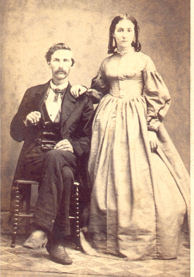|
|
Civil War Dresses for Every-Day Wear
by Miriam Sullivan, for www.classicattire.com
 Introduction:
Introduction:
The purpose of this article is to help those who want to make sure that their Civil War wardrobe is historically accurate, or are interested in the Civil War time period and would like to know more about its fashions. The majority of dresses from the Civil War, although varying in their particulars, hold true to certain guidelines.
General Design:
During the Civil War era, dresses were designed to make the
waist appear smaller. They were made to be durable and to last as long
as possible without showing wear.
Skirts were very full so as to accommodate a crinoline or hoop skirt, and were usually knife pleated or gauged, (hand-gathered in a time consuming manner), into the waistband.
Shoulders on bodices were gracefully dropped so that the top of the sleeve sat on the upper arm. Sleeves were wide, often peaking in width at the elbow, so as to make the waist appear smaller.
The bodice was
lined and very form-fitting. The bottom of the bodice sat a little above
the natural waist and was generally either straight or pointed to the
front. The back of the bodice was made in three pieces - a center back
and two side backs. These met in elegant curves and formed a kind of "V"
design. The shoulder seams sat far back on the shoulder. The front of
the bodice fastened with hooks-and-eyes or buttons. Necklines were made
in a high, circular, jewel style, and were worn with white collars. 
If you wish your dress to look period correct you will need a corset; undergarments do make a difference.
Sleeve Styles:
There were three basic sleeve styles that were quite popular in
the Civil War; although there were many variations on these three, their
most basic forms are:
Coat sleeves (to the right) were very popular in the Civil War era. These were made in two pieces which were curved on both sides so as to follow the bent of the arm. They were gathered into a cuff or left open.
Pagoda sleeves (see picture at top) were tapered; they were narrower at the top and wider at the bottom, which ended before the wrist and were left open. They were worn with full under-sleeves.
Bishop sleeves (see picture below) were made of one piece and gathered into the armhole at the top and the cuffs at the bottom.
 A side note:
A side note:
You may notice that my title reads "every-day wear," where I
would usually say "day dresses." Although "day dress" is a term
generally understood among re-enactors to refer to any "every day" Civil
War era dress, it was not used in this manner in the 1860's. I do,
however, often use the term because its modern meaning is generally
understood. During the Civil War, dresses used for every-day wear where
not all grouped under any title, any more than modern dresses are today.
A Further Side Note:
The people shown in the illustrations of this article are my
relatives (aunts, uncles, etc.); the pictures came from a family album.
They are working-class, every-day (in that sense :-)), people, wearing
every-day dresses.
For further research see:
Glenna Jo & Bill Christen's website, The Curiosity Shop, which has much valuable information.
Fanny & Vera's Helpful Hints for Civil War Reenactors.
Gotham Pattern's Woman's Clothing